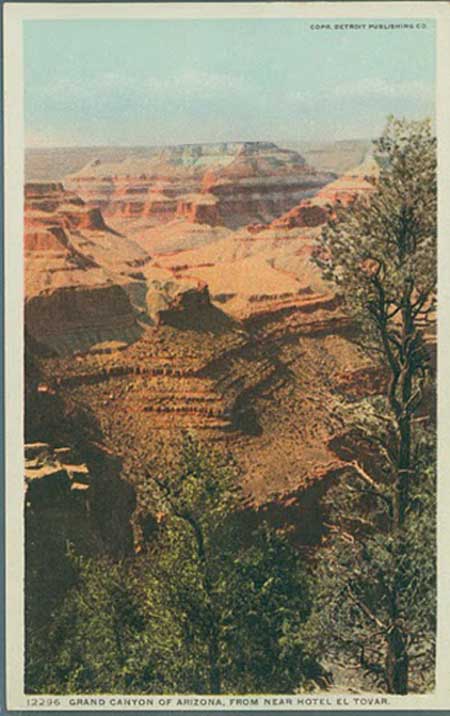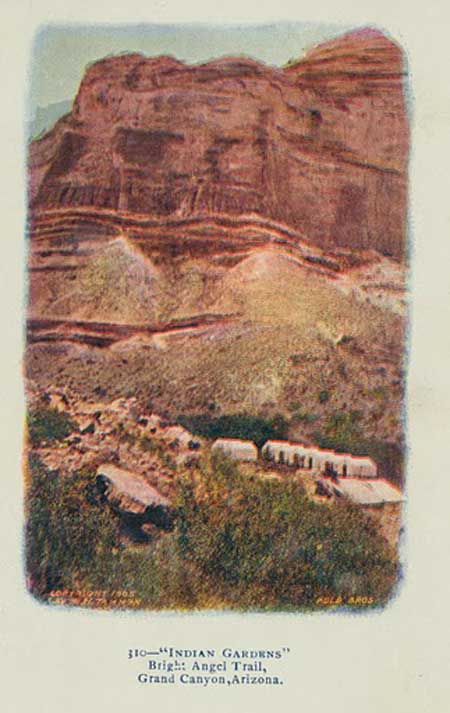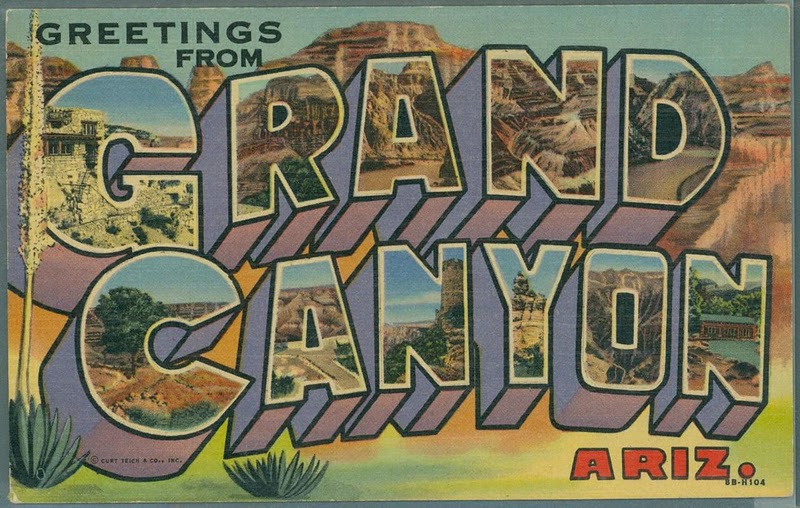How do we see the Grand Canyon? If you are lucky enough to travel to the Canyon, you may experience it with your sense of sight, smell, sound, and touch. You may take in the play of light and shadows on the canyon’s walls and the changing hues as the sun rises or sets. These experiences combine to create a personal vision of the Grand Canyon, one grounded in first hand knowledge and memory of the place. For many people, however, seeing the Grand Canyon is only possible through other people’s eyes. A trip to the Grand Canyon may be too expensive, require too much time away from work or other family commitments, or not be physically possible. These virtual visitors will view the canyon through photographs, paintings, and sketches made by other intrepid travelers. Paintings, photographs and evocative verbal descriptions abound in the published literature on the Grand Canyon. But another source of visual information about the canyon, often overlooked, comes from postcards.
Visitors to the Grand Canyon have used postcards to share their experiences with friends and family for over 100 years. Postcards emerged from European roots in the 1870s, where printed trade and advertising cards were used to draw popular attention to products and services for sale. By the 1890s, they were also employed widely to advertise tourist attractions and designed so that purchasers could send them by mail. Europeans eagerly collected and circulated picture postcards or “view cards” as they were also known. Picture postcards became popular in the United States after 1893 when the first souvenir picture postcards were sold at the Columbian Exposition in Chicago.
They generally had an image on the front of the card and the mailing address on the back of the card. At that time, postal service regulations stipulated that only the postal address was allowed on the back of the postcard—no personal notes. Senders of these early picture postcards consequently wrote their notes around the edges of the image on the front of the card, often in the narrow blank border around the picture. Regulations soon changed. By 1902 in Europe and by 1907 in the United States postcards had a divided back, a printed line separating the back of the card into two sections, one for the address and one for a personal note. Postcard production and use skyrocketed after this innovation. The cheap price—one-cent postage rate in the U.S.—and speedy delivery helped popularize this new communication medium.
Some of the earliest postcard images of the Grand Canyon were manufactured by the Detroit Publishing Company. Using photographers, artists, and a patented print making process, Detroit Publishing created hundreds of images of the Grand Canyon during their production years 1895-1924. The company became one of the world’s leaders in postcard manufacturing by acquiring an immense photographic collection and creating unique products through a refined lithographic print method. Its postcard representations of the Grand Canyon were usually sold by the Fred Harvey Company, which ran the tourist concession for the Santa Fe Railway at Grand Canyon and many other national parks. Many of the Detroit Publishing postcards depicting scenes at the Grand Canyon have the Fred Harvey logo on them.
As postcard manufacturing grew more efficient and less expensive many businesses and individuals began producing Grand Canyon postcards. For example, the Kolb Brothers, known for their spectacular photography of the Grand Canyon, and others such as Bill Bass, printed and sold Grand Canyon postcards.
Curt Teich and Company, Inc. was another very large and prominent manufacturer of picture postcards. During its years of operation from 1898 to 1978, Curt Teich was the world’s leading printer of view and advertising postcards. Like the Detroit Publishing Company, Curt Teich advanced postcard manufacturing techniques using technological innovations and international pools of talent. It was the most prolific producer of high quality linen postcards from 1931 until well into the 1950s. These linen postcards had a texture that made the colored ink stick better to the paper and gave the postcards a distinctive feel that distinguished them from cheaper postcards of the day.
Some of the most common scenes depicted in postcards of the Grand Canyon featured popular tourist activities and rim-side views. The scenes and locations of Grand Canyon postcards changed over time reflecting shifts in the canyon’s cultural landscape and the things people valued in this national park. Postcards are a valuable visual tool for exploring the history and culture of tourism at the Grand Canyon. Take a tour of some these images here or in the “archives” section of this website. All the postcard images were scanned from the extensive collection available at the Grand Canyon Museum archive managed by the Park Service on the South Rim.
Written By Yolonda Youngs
Suggested Reading:
- Digital Past 2008. Lake County Museum, Wauconda, IL. February 2008 to December 2008. Available from http://www.digitalpast.org.
- Miller, G., and Miller, D. 1976. Picture postcards in the United States, 1893 -1918. New York: Clarkson N. Potter.
- Rowe, J. 2006. Arizona real photo postcards: History and portfolios. Nevada City: Carl Mautz Publishing.
- Stechschulte, N. 1994. The Detroit Publishing Company Postcards. Big Rapids, MI: Nancy Stickels, xi.
- Stechschulte, N. 1994. The Detroit Publishing Company Postcards. Big Rapids, MI: Nancy Stickels.
- Werther, M. and Mott, L. 2002. Linen Postcards: Images of the American Dream. Wayne, Pennsylvania: Sentinel Publishing.
- Youngs, Y. 2009. The Grand Canyon: Nature, Vision, and History. Doctoral dissertation. Department of Geography, Arizona State University.




